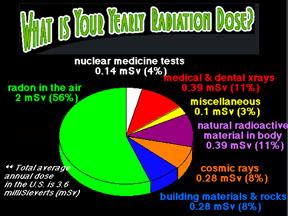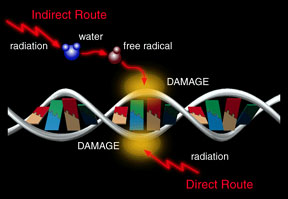Radiation can damage the DNA in the cells of living things. Damaged DNA can make the cell stop working or unable to reproduce. It can also cause the cell to grow out of control, causing cancer.
Click on image for full size
Source unknown.
Radiation Hazards to Living Creatures
Radiation can be harmful to living creatures. Radiation can harm living things directly by damaging their cells. The cells might stop functioning, or they might be unable to reproduce. Radiation can also cause cells to reproduce in an out-of-control fashion, causing cancer.
Radiation can also interfere with the reproduction of living things. It can cause sterility, making reproduction impossible. It can also cause mutations in offspring, which are usually detrimental or even fatal.
Animals (including humans) tend to be more susceptible to the harmful effects of radiation than plants. Some types of microbes are tolerant of high doses of radiation that would easily kill multicelled organisms.
Natural sources of radiation play a role in the long-term evolution of species. Some (a very, very tiny fraction) mutations caused by radiation turn out to be beneficial. They give certain organisms a better chance to survive. Sometimes mutations caused by radiation produce a more successful and better-adapted new species.
You might also be interested in:

Radiation comes in two basic types: electromagnetic radiation transmitted by photons, and particle radiation consisting of electrons, protons, alpha particles, and so forth. Electromagnetic radiation,
...more
High frequency radiation or fast moving particles plow into a living cell with enough energy to knock electrons free from molecules that make up the cell. These molecules with missing electrons are called
...more
Though not the largest kingdom, with a mere 300,000 species catalogued, many might argue that the Kingdom Plantae just may be the most important group of living organisms. In the process known as "photosynthesis",
...more
Some environments are inhospitable to most "normal" living creatures. However, these extreme environments are not necessarily lifeless. Certain types of organisms, known collectively as "extremophiles",
...more
This page describes extreme environments that are acidic or alkaline, are exposed to high levels of radiation, are under tremendous pressure, or are hostile to "normal" life in a number of other unusual
...more
This Windows to the Universe Exploratour examines the scientific evidence of biological evolution. Take the tour to travel through 10 web pages about the scientific theory that explains how and why living
...more
Astronauts are exposed to many different types of dangerous radiation in space. Space agencies, like NASA, must carefully monitor the radiation exposure of astronauts to make sure they remain safe and
...more













